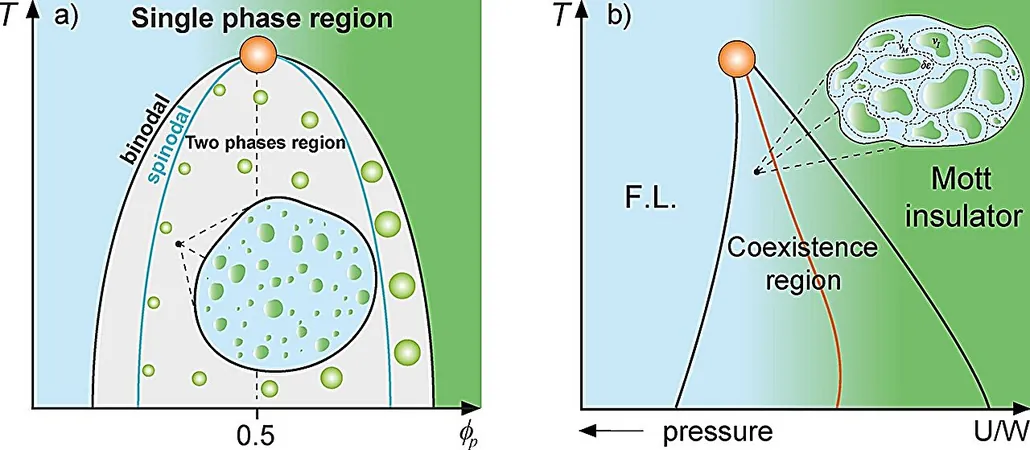
Breakthrough Study Reveals How Proteins Create Droplets Inside Cells — What It Could Mean for Life and Medicine!
2024-10-11
Author: Jacob
Introduction
In an exciting new study, scientists at São Paulo State University (UNESP) in Brazil have applied concepts from condensed matter physics to unveil a fascinating mechanism of protein behavior inside cells. Their research proposes that proteins can compartmentalize and form droplets, akin to liquid-liquid phase separation, which plays a crucial role in cellular function and possibly even the origins of life itself.
Study Overview
Published in the esteemed journal Heliyon, the study is led by Ph.D. candidate Lucas Squillante with the guidance of Professor Mariano de Souza. It draws parallels between protein droplet formation in cells and the well-known Griffiths phase found in magnetic and electronic systems. This innovative perspective allows researchers to think about how proteins can create 'rare regions' within the cell, which could significantly impact cellular dynamics.
Professor de Souza's Insights
Professor de Souza explained, “In the magnetic Griffiths phase, unique regions with different magnetic properties appear within a uniform matrix. Similarly, our study indicates that protein droplets can emerge randomly, affecting cellular stability and dynamics.” According to their findings, once the protein concentration within a cell crosses a specific threshold, proteins begin to cluster together, forming droplets that can alter cellular processes and gene expression.
Origins of Life
This research also delves into the deeper implications of protein compartmentalization concerning the origins of life. It aligns with Aleksandr Oparin’s classical theory, suggesting that only coacervates—basically clusters of organic molecules—capable of slow dynamics could have survived and evolved in primordial environments. “This phenomenon may also tie back to the essential concept of homochirality, which is critical for life’s molecular machinery,” noted de Souza.
Gene Expression Optimization
Moreover, the study demonstrates that as protein diffusion time increases, stochastic fluctuations within cells decrease. This stabilization could be key in optimizing gene expression, which is vital for proper cellular function.
Medical Implications
What really catches the attention of the scientific community is the potential of this Griffiths-like cellular phase in medical research. Professor Marcos Minicucci, a co-author of the study, pointed out its profound implications for understanding diseases. By highlighting the significance of liquid-liquid phase separation, researchers express interest in its relevance to various conditions. “From tumors to neurodegenerative diseases, understanding how proteins compartmentalize can shed light on disease mechanisms and potential treatments,” he said.
Connecting to Global Health
Intriguingly, the research also connects to pressing global health issues, such as the response to COVID-19. It has been observed that the coacervation of specific proteins can suppress the immune response to the SARS-CoV-2 virus, illustrating the delicate balance within cellular processes.
Conclusion
Ultimately, the study emphasizes the need for interdisciplinary approaches in tackling fundamental scientific questions. The findings not only enhance our understanding of protein dynamics but also open doors to possible therapeutic strategies that leverage these insights to combat diseases ranging from cancer to microbial infections.
Future Outlook
As this groundbreaking work continues to unfold, one can't help but wonder: could the secrets of life and advanced medicine lie within the simple act of protein droplet formation? Stay tuned, as science unpacks more about the mysterious world inside our cells!









 Brasil (PT)
Brasil (PT)
 Canada (EN)
Canada (EN)
 Chile (ES)
Chile (ES)
 España (ES)
España (ES)
 France (FR)
France (FR)
 Hong Kong (EN)
Hong Kong (EN)
 Italia (IT)
Italia (IT)
 日本 (JA)
日本 (JA)
 Magyarország (HU)
Magyarország (HU)
 Norge (NO)
Norge (NO)
 Polska (PL)
Polska (PL)
 Schweiz (DE)
Schweiz (DE)
 Singapore (EN)
Singapore (EN)
 Sverige (SV)
Sverige (SV)
 Suomi (FI)
Suomi (FI)
 Türkiye (TR)
Türkiye (TR)